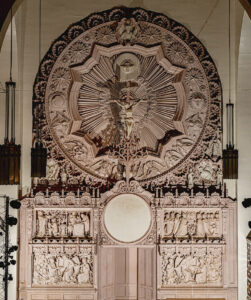 SM from the St Anthony’s Community asked me to appraise their altar candelabra. This gave me a private moment in that 1927 Chapel. Throughout California in the late 1920s towns saw a boom in a certain symbolic style of architectural decoration. Anyone who visited San Diego’s Balboa Park or San Francisco’s Palace of Fine Arts will recognize this style. Santa Barbara contributed to this style in perhaps the most distinctive sculptural work, located in the rarely seen St. Anthony Chapel on Garden Street.
SM from the St Anthony’s Community asked me to appraise their altar candelabra. This gave me a private moment in that 1927 Chapel. Throughout California in the late 1920s towns saw a boom in a certain symbolic style of architectural decoration. Anyone who visited San Diego’s Balboa Park or San Francisco’s Palace of Fine Arts will recognize this style. Santa Barbara contributed to this style in perhaps the most distinctive sculptural work, located in the rarely seen St. Anthony Chapel on Garden Street.
The whole complex, once Seminary, when sold by the Franciscans, became the Garden Street Academy and recently landed on the auction block. The St Anthony’s Community celebrated mass in that chapel since 1968 when the Franciscan fathers invited the public to join them in the previously private Chapel. Now the group of worshippers, an inclusive Catholic community, must leave. The centerpiece is the Chapel’s Reredos, the highly symbolic frontispiece behind that altar.
The style combines Spanish Renaissance 16th century plateresque, ornate silversmithing, and the mystery, mannerism, and exoticism of the late 1920s. An element of “set design” also prevails in this era of silent film. This reredos, huge at twenty-two feet by thirty-eight feet, is a gem, with close cousins in San Diego. But nothing is as impressive as the back wall of the St Anthony Chapel in Santa Barbara.
Designed by Ross Montgomery
Architect Ross Montgomery took on rebuilding the chapel and other buildings after the 1925 earthquake. He requested the well-known cast stone sculptor Christian Mueller. Montgomery re-designed the St Antony Chapel for the Franciscan friars in the Romanesque style with an Italian Renaissance campanile visible for miles at 160 feet high. Mueller already achieved one show-stopping sculptural façade previously. In concert with the great San Diego architect William Templeton Johnson (1877-1950), they designed the San Diego Museum of Art, beginning in 1922, opening February 28, 1926.
Mueller added to that façade life size figures of Spanish Old Master painters Velazquez, Murillo, and Zurbaran. He included a small Michelangelo’s David, plus added heraldic devices of the coats of arms of Spain, the USA, California, and San Diego. Burbank based Mueller had an apprentice—his twenty-year-old son Chris Mueller. The younger worked with his dad on the massive half “clam shell” fan over the San Diego Museum entryway completed in 1926. Note the underwater themes Chris Mueller developed later in his career. Mueller, senior and junior, spent the rest of 1926 devoted to St Anthony’s Chapel Reredos. They completed the project, consecrated as Christ the King Chapel on May 27, 1927, under Friar and Seminary Rector Theophilus Richardt.
Elder Mueller’s career in cast stone, actually a type of poured and molded concrete, extended to Federal and State buildings in Sacramento. He also worked on St Paul’s Cathedral in Chicago, Sacred Heart and St Ignatius Churches in San Franscisco, and architect Betram Goodhue’s 1918 Park Avenue Church, St Bartholomew.
Mueller’s Hollywood Connection
As Mueller’s son Chris developed as an artist, he found work in Hollywood films of the 1950s. He sculpted the giant squid in 20,000 Leagues Under the Sea (1954) and the title character for The Creature from the Black Lagoon. In the 1960s he designed Disney’s Haunted Mansion, Florida’s Disney Palace, and Disney’s Jungle Boat ride. In the 1970s he returned to San Diego to restore his father’s 1920s work in Balboa Park of architectural elements originally cast in plaster with a meagre support of hay and wood.
Mueller Jr’s masterpiece is the restoration of the decorative architecture of Carleton Winslow’s (1876-1946) Panama California International Exposition Food and Beverage Building (1915-16). He created a permanent installation of the old plaster palace, renamed the Casa del Prado in 1970. The pair of eighty-foot-tall towers at the entrances harkens back to the beginning of his career under his dad at St Anthony’s Chapel. This great architectural tradition, uniquely California, continues to fascinate in its symbolism. Note the large white unadorned disc in the middle of the Reredos. That is the wafer, which after Consecration, symbolizes the body of Christ. The tree references Adam and Eve.